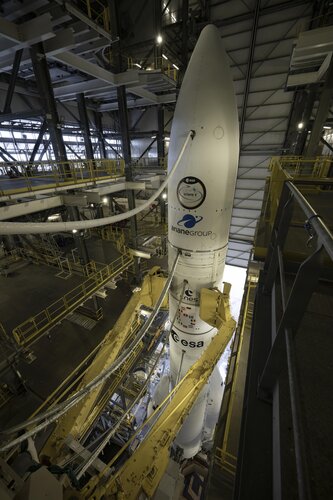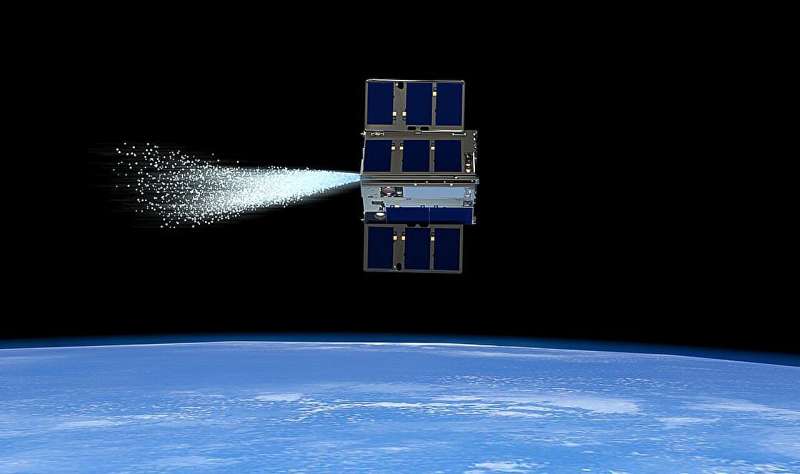
Copernical Team
MIT engineers find a way to protect microbes from extreme conditions
 Microbes that are used for health, agricultural, or other applications need to be able to withstand extreme conditions, and ideally the manufacturing processes used to make tablets for long-term storage. MIT researchers have now developed a new way to make microbes hardy enough to withstand these extreme conditions.
Their method involves mixing bacteria with food and drug additives from a
Microbes that are used for health, agricultural, or other applications need to be able to withstand extreme conditions, and ideally the manufacturing processes used to make tablets for long-term storage. MIT researchers have now developed a new way to make microbes hardy enough to withstand these extreme conditions.
Their method involves mixing bacteria with food and drug additives from a Ariane 6 the day before launch
 Image:
Ariane 6 the day before launch
Image:
Ariane 6 the day before launch Nearby Exoplanet Found with Hydrogen Sulfide Atmosphere
 A recent study by Johns Hopkins University, utilizing data from the James Webb Space Telescope, has uncovered that the atmosphere of the exoplanet HD 189733 b contains trace amounts of hydrogen sulfide, known for its rotten egg odor.
HD 189733 b, a gas giant similar in size to Jupiter, reveals new information about sulfur's role in planetary formation and atmospheric composition. The prese
A recent study by Johns Hopkins University, utilizing data from the James Webb Space Telescope, has uncovered that the atmosphere of the exoplanet HD 189733 b contains trace amounts of hydrogen sulfide, known for its rotten egg odor.
HD 189733 b, a gas giant similar in size to Jupiter, reveals new information about sulfur's role in planetary formation and atmospheric composition. The prese SpaceX Successfully Launches Turkey's First Home-Grown Communications Satellite
 SpaceX has launched a Falcon 9 rocket from Cape Canaveral Space Force Station on Monday night, carrying Turkey's first home-grown communications satellite.
The launch took place at 7:30 p.m. EDT after being delayed due to bad weather. The event was streamed online for viewers worldwide.
"All systems are looking good for today's launch of the @Turksat 6A mission from Florida. Weather
SpaceX has launched a Falcon 9 rocket from Cape Canaveral Space Force Station on Monday night, carrying Turkey's first home-grown communications satellite.
The launch took place at 7:30 p.m. EDT after being delayed due to bad weather. The event was streamed online for viewers worldwide.
"All systems are looking good for today's launch of the @Turksat 6A mission from Florida. Weather Subaru Telescope Discovers New Objects Beyond the Kuiper Belt
 The Subaru Telescope's comprehensive imaging has significantly contributed to the New Horizons mission, revealing potential extensions of the Kuiper Belt in the outer Solar System. By utilizing a unique analytical method on images captured by the telescope's ultra-wide-field camera, researchers have identified objects that might extend the known boundaries of the Kuiper Belt.
Beyond Neptun
The Subaru Telescope's comprehensive imaging has significantly contributed to the New Horizons mission, revealing potential extensions of the Kuiper Belt in the outer Solar System. By utilizing a unique analytical method on images captured by the telescope's ultra-wide-field camera, researchers have identified objects that might extend the known boundaries of the Kuiper Belt.
Beyond Neptun Martian Atmosphere Unveiled Through Innovative Use of Existing Technology
 An antenna on ExoMars' Trace Gas Orbiter has been repurposed to help researchers explore new areas of the Martian atmosphere.
Using this modified equipment, a team including researchers from Imperial College London has investigated previously unreachable regions of Mars' atmosphere. These areas, which can obstruct radio signals, are vital for future Mars habitation missions.
The anal
An antenna on ExoMars' Trace Gas Orbiter has been repurposed to help researchers explore new areas of the Martian atmosphere.
Using this modified equipment, a team including researchers from Imperial College London has investigated previously unreachable regions of Mars' atmosphere. These areas, which can obstruct radio signals, are vital for future Mars habitation missions.
The anal Orion and SLS Gearing Up for Major Artemis Missions
 NASA's Artemis program, aimed at returning humans to the Moon and beyond, is making significant strides with key developments in the Orion spacecraft and the Space Launch System (SLS) rocket. These advancements are vital as the space agency prepares for a series of increasingly ambitious missions to explore cislunar space and establish a sustainable human presence on the Moon.
b>Orion Spa
NASA's Artemis program, aimed at returning humans to the Moon and beyond, is making significant strides with key developments in the Orion spacecraft and the Space Launch System (SLS) rocket. These advancements are vital as the space agency prepares for a series of increasingly ambitious missions to explore cislunar space and establish a sustainable human presence on the Moon.
b>Orion Spa Artemis IV Set to Launch with Modernized RS-25 Engines
 Aerojet Rocketdyne, an L3Harris Technologies (NYSE:LHX) company, has successfully upgraded the four RS-25 engines that will propel NASA's Space Launch System (SLS) rocket for the Artemis IV mission. This mission will feature the first flight of the advanced Block 1B configuration of the SLS rocket and will be the last to use engines from the space shuttle era.
The upgraded Artemis IV engin
Aerojet Rocketdyne, an L3Harris Technologies (NYSE:LHX) company, has successfully upgraded the four RS-25 engines that will propel NASA's Space Launch System (SLS) rocket for the Artemis IV mission. This mission will feature the first flight of the advanced Block 1B configuration of the SLS rocket and will be the last to use engines from the space shuttle era.
The upgraded Artemis IV engin Germany's Integral Role in the Ariane 6 Launch Program
 The Ariane 6, Europe's new launcher, is set for its maiden voyage on 9 July 2024. This rocket aims to provide Europe with reliable and cost-effective access to space, succeeding the Ariane 5 while offering greater flexibility. Germany stands as the second-largest contributor to the European Space Agency's (ESA) Ariane 6 program, with the German Space Agency at the German Aerospace Center (DLR) i
The Ariane 6, Europe's new launcher, is set for its maiden voyage on 9 July 2024. This rocket aims to provide Europe with reliable and cost-effective access to space, succeeding the Ariane 5 while offering greater flexibility. Germany stands as the second-largest contributor to the European Space Agency's (ESA) Ariane 6 program, with the German Space Agency at the German Aerospace Center (DLR) i CubeSat propulsion technologies are taking off

CubeSats are becoming ever more popular, with about 2,400 total launched so far. However, the small size limits their options for fundamental space exploration technologies, including propulsion. They become even more critical when mission planners design missions that require them to travel to other planets or even asteroids.
A team from Khalifa University of Science and Technology in Abu Dhabi recently released a review in Aerospace of the different CubeSat propulsion technologies currently available—let's look at their advantages and disadvantages.
The paper breaks propulsion systems into four categories: Chemical, Kinetic, Electrical, and "Propellant-less." Chemical systems are the traditional rockets most people think of when launching satellites—they burn chemicals together and expel gas created by the fire to produce thrust. Kinetic systems use things like cold gas, where instead of reacting two chemicals together, they simply push gas molecules out to propel themselves in the opposite direction.
